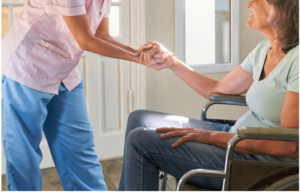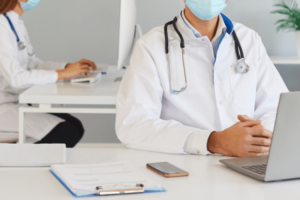A GREAT INNOVATION TO HEALTHCARE
The shift in healthcare in the 21st century is going towards a positive direction with the help of technological advancements and continuing research on medical innovation. One of the trends in today’s modern medical world is telehealth – and this includes Remote Patient Monitoring. RPM is not a new concept since it has existed for a long time now, although its peak popularity was recognized at the height of the pandemic. From there, RPM became one of the services being sought-after by medical providers and patients because of its efficiency and efficacy in improving patient care.
This innovation in healthcare can be adapted in home health care to help clinicians monitor their patients remotely using technologies that give information about the patient’s current condition – one of which is real-time report on patients’ vital signs. Even if patients are at their own homes, their current illness can be managed well through strict monitoring. For healthcare providers, this eases their worry about the current status of their patients by being knowledgeable and well-informed about their patients’ everyday health status.
In fact, CMS stated that “proposed changes promote innovation to modernize home health by allowing the cost of remote patient monitoring to be reported by home health agencies as allowable costs on the Medicare cost report form.”. (Centers for Medicaid and Medicare Services [CMS], 2018, para. 4).
HOW GAPS IN HEALTHCARE AFFECT THE QUALITY OF PATIENT CARE
Healthcare providers always want the best for their patients, and patients always want the best outcome for their treatments received. But despite this, healthcare service delivery still could fall short in one way or another. These gaps in healthcare happen when inconsistencies occur during or after a service is provided, particularly when not enough communication is exchanged between patients and providers.
Let’s take a look at some scenarios that manifest gaps in healthcare:
- Maintenance medicine not being taken on a regular basis
- Regular health check-ups being forgotten
- Diagnostic tests not done regularly (for those who need them)
- A patient jumping from one healthcare provider to another
- Patients unable to get the care they need due to remote location
- Patients’ newly diagnosed condition not shared with the appropriate health specialist
As healthcare continues to progress over time, gaps in patient care can be abridged through technological advances. It is evident that sufficient and effective data collection on patients’ current status can help prevent these gaps that may lead to even more comorbidities for patients. Understanding and recognizing gaps in healthcare can assist in providing better patient care.
BRIDGING THE GAP IN HEALTHCARE WITH THE HELP OF RPM
The data collected with RPM is shared with patients and healthcare providers which is beneficial for both sides:
- Patients become more aware of their condition, which helps them make necessary changes to their lifestyle to improve their quality of life
- Patients have the option to remain in the comfort of their homes all the while still receiving necessary care and education from healthcare providers, which also means lesser exposure to hospital-acquired illnesses
- Overall, time and energy spent for travel to the doctor’s office or hospital is lessened, greater expenditure saved due to lesser trips outside of home
- Healthcare providers are provided real-time data on the status of their patients, allowing them to make healthcare planning more in tune to the patients’ needs
- Healthcare providers kept in the loop of patients’ condition, allowing providers the capacity to manage patients’ medical needs appropriately – necessarily adjusting medication when needed, regularly updating patient education, lesser chances of emergency-care visits through prevention
- Health care accessibility is improved for patients in remote locations, decreasing chances of missed opportunities for care
- Generally, communication between patient and healthcare providers is improved and more in-depth with back-up data from RPM devices
RPM can be an adjunct to healthcare in providing a better quality of service. Preventative care can be highlighted instead of treating the after-effects of healthcare gaps that leads to development of chronic illnesses.
WHAT ARE RPM DEVICES?
Remote Patient Monitoring devices use technology to remotely input patients’ health status through monitoring, reporting, and analyzing data collected from the device attached to the patient.
Here are 5 RPM devices most commonly used by patients and healthcare practitioners:
- Blood pressure monitor – used to measure blood pressure with the use of a sphygmomanometer and could either be a manual or automatic BP monitor; BP monitoring is a safe and painless assessment used to measure one’s blood pressure; important for prevention and evaluation of overall health, and helps manage existing hypertension
- Pulse oximeter – used to measure oxygen saturation to determine if the patient has enough oxygen supply in the blood; device is usually clipped unto patient’s fingers
- Weight monitor – helps patients and clinicians keep track of patient’s weight regularly
- Spirometer – used to measure ventilation, or the movement of air into and out of the lungs to help monitor its condition
- Blood glucose monitor – used especially for diabetic patients to measure blood sugar levels; vital to managing diabetes type I & II
These devices help give information regarding the patient’s status – if their health is on track or an if an immediate action is necessary to help improve patients’ health. With RPM, preventive measures could be taken so as to decrease risk of developing infections or comorbidities for patients, ultimately reducing financial cost for both patients and healthcare providers alike. It is clear why Remote Patient Monitoring is here to stay as it is considered one of the greatest innovations in healthcare.
REFERENCES:
- Centers for Medicare & Medicaid Services. (2018, October 31). Cms takes action to modernize medicare home health | cms. Retrieved April 27, 2022, from https://www.cms.gov/newsroom/press-releases/cms-takes-action-modernize-medicare-home-health-0





